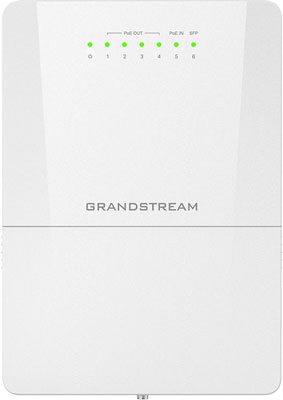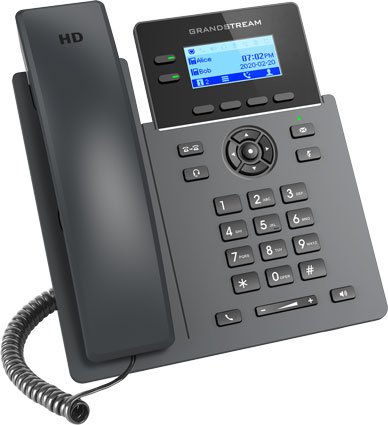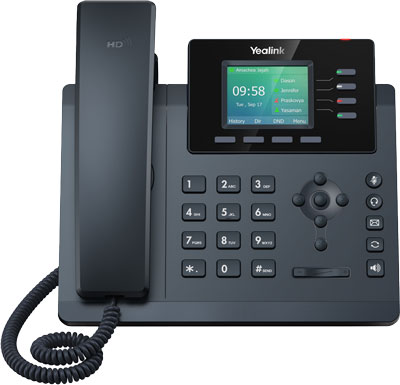When setting up a VoIP phone, there’s a basic question you have to answer: Will you use a power supply or PoE to power the phone?
The vast majority of VoIP phones — but not all — have both a power port and an Ethernet port that supports PoE. However, it might not be clear when you need to use one or the other.
In this blog, we clearly explain when you should use a power supply and when you should use PoE.
But first, we’re going to answer a question that you might be asking: What is PoE? We’re not talking about the writer of spooky stories nor the 90’s singer/songwriter.

What Is Power Over Ethernet (PoE)?
Power Over Ethernet (PoE) is a long-established industry standard for delivering power to an electronic device via the same Ethernet cable that connects it to the network.
You deliver PoE power via a PoE switch, which is a standard network switch that can also handle power delivery, or a PoE injector (also known as a PoE midspan), which is an adapter that “injects” power into an Ethernet cable. You use standard Ethernet cables (minimum CAT5) for PoE.
The endpoint must be capable of receiving PoE power. Almost every VoIP phone is PoE-ready, but always double-check in the phone’s specs.
Another thing to know is that there are different amounts of power that PoE switches/injectors can deliver and that PoE devices require, just like your fridge needs more power than your reading lamp. So you need to make sure the power your devices handle match their requirements.
For an in-depth discussion of PoE, check out our clear, expert blog, “The Ultimate Guide to Using PoE (Power Over Ethernet) to Power IP Devices.”

What are the advantages of using a power supply for a VoIP Phone?
There are benefits to using a power supply for a VoIP phone:
Wi-Fi phones. If you use Wi-Fi to connect the VoIP phone to your network, you’ll want to use a power supply. After all, if you can make a physical Ethernet connection, why use Wi-Fi?
A side note: Just because a phone supports Wi-Fi doesn’t mean it has a battery. Nearly every Wi-Fi desk phone needs to be plugged in continuously. (Yealink CP935W, however, does have a battery.)
Home office. Chances are really good that you don’t have a PoE switch in your home office. And, unless you’re a tech enthusiast, you probably don’t want to worry about setting up a PoE switch or PoE injector at home. So many, if not most, home office workers use a power supply, even if they use an Ethernet cable to connect to the network.
Also, home office workers often prefer to use Wi-Fi over Ethernet to connect to the network, because running cable around the house can be ugly and setting up an Ethernet drop can be more expensive than it’s worth. Using Wi-Fi means using a power supply in pretty much all cases.
Not paying for a PoE switch/injector. If you only have a small number of VoIP phones and you want to avoid learning how to use PoE, you might just prefer the simplicity of a power supply. (That said, setting up PoE isn’t difficult and once it’s set up you don’t need to worry about it.)

What are the disadvantages of using a power supply for a VoIP phone?
There are reasons to avoid using a power supply for a VoIP phone:
Paying for a power supply. Because VoIP phones are more often powered by PoE than by power supplies and because companies want to reduce e-waste, most VoIP phones don’t come with a power supply in the box. You need to buy it separately.
However, if a VoIP phone is specifically intended to be used with Wi-Fi, it might come with a power supply. Double-check the package contents with the manufacturer before purchase!
If you need a separate power supply for your phone, make sure you get the official power supply for the phone made by the phone’s manufacturer. Power supplies are specific to particular models of phones, so a power supply for one Yealink phone might not work for another Yealink phone.
If you need help figuring out what power supply is compatible with your phone (it can be confusing), get in touch. Our VoIP phone experts will guide you to the right product.
Paying for an electrician. Power supplies require electrical outlets, obviously. And electrical outlets aren’t always conveniently placed. If you need to install a new outlet, you need to pay for an electrician, and we don’t need to tell you how expensive that can be. Ethernet cable, on the other hand, doesn’t require an electrician to install, saving you potentially a lot of money.
Network stability. If you’re using PoE, you’re also using an Ethernet cable to connect to the network. While Wi-Fi has gotten much better, a physical Ethernet connection is still the gold-standard for reliability and speed. So doing the bit of extra work to run some cable can provide a much better experience.

What are the advantages of using PoE for a VoIP phone?
There’s a reason why PoE is the more common method of powering VoIP phones. In fact, there are quite a few reasons:
Streamlined infrastructure. Using PoE makes your network infrastructure organized and clutter-free. One cable, that’s all. No extra power supply you need to find a plug for.
Typically, a VoIP phone has two Ethernet ports on it. One port is used to connect to the network; this is the port that supports PoE. The second port is used to daisy-chain the network connection to another device. For example, you’ll probably have your VoIP phone right next to your computer. You can run a cable to the phone, then run a short cable to the computer: both devices will be able to connect to the internet that way from a single cable run. Know, however, that the second port won’t be able to provide PoE power to the connected device.
Stable network connectivity. Because physical network connectivity is more stable and reliable than Wi-Fi, by using PoE you get better network performance out of your devices at the same time as powering them: win-win.
Phone availability. Most VoIP phones still don’t natively support Wi-Fi, which means they need to connect to the network via an Ethernet cable. Some phones support Wi-Fi via a USB adapter, which is almost always available separately. That means you have to pay for the adapter on top of the phone. Using the USB adapter also means that USB port is in use when you might want to use it for a USB headset or a Bluetooth adapter.
The price of running Ethernet cable. Ethernet cable is comparatively inexpensive and you don’t need to hire an electrician to run the cable. You just need a network technician or you can do it yourself.
No need for separate purchases. Power supplies are often not included in the box with a VoIP phone, because PoE is the more common method of powering VoIP phones and to reduce e-waste. That means that you often need to buy a power supply separately from the phone. With PoE, you save that money.
Long-distance cable runs. PoE power can be driven through Ethernet cables for 100 feet. And there are PoE extenders that can, well, extend that length much more. So if, for example, you need to power VoIP phones across a large office building, you don’t need to worry about setting up as many switches.

What are the disadvantages of using PoE for a VoIP phone?
While PoE is a great option, there are a couple of reasons why you wouldn’t want to use it:
Wi-Fi. If you want to use Wi-Fi, you’ll want to use an external power supply, simple as that. We cover this in more detail above.
Avoid switches and injectors. You might want to avoid setting up and managing additional tech devices like a PoE switch. In this case, using a power supply might be preferable.

